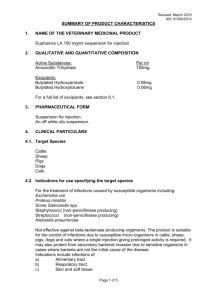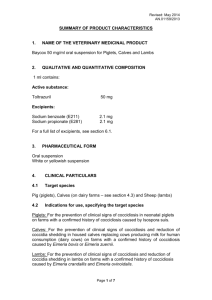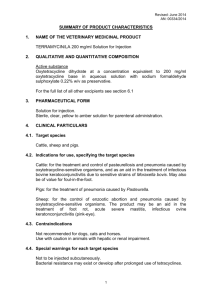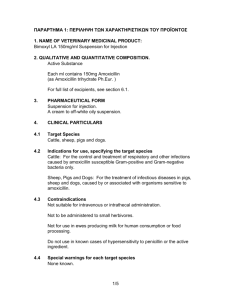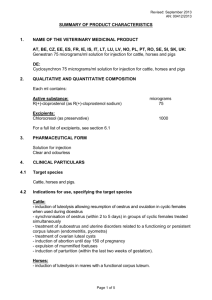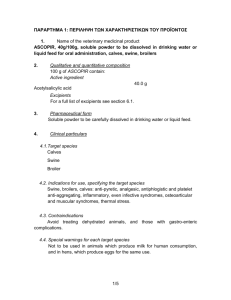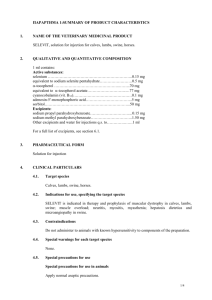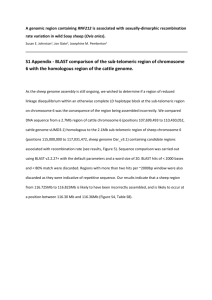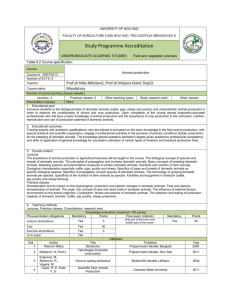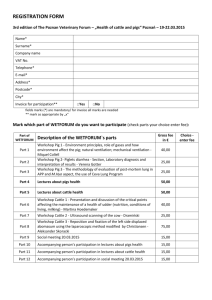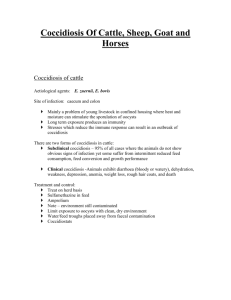Revised: July 2015 AN: 01319/2014 SUMMARY OF PRODUCT
advertisement
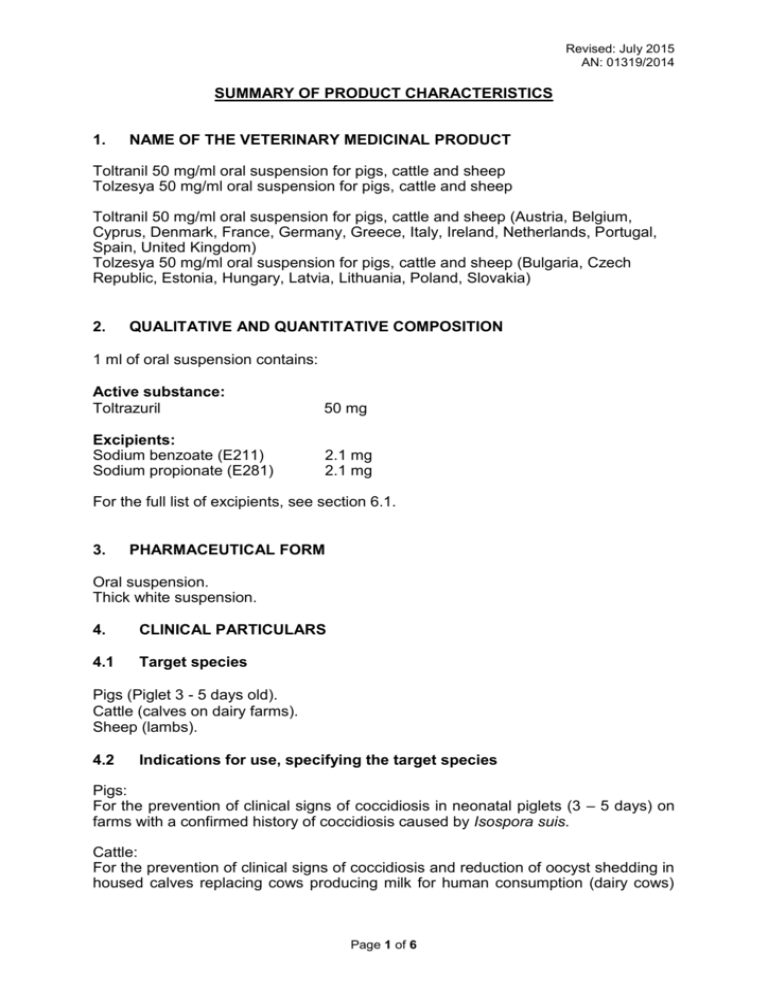
Revised: July 2015 AN: 01319/2014 SUMMARY OF PRODUCT CHARACTERISTICS 1. NAME OF THE VETERINARY MEDICINAL PRODUCT Toltranil 50 mg/ml oral suspension for pigs, cattle and sheep Tolzesya 50 mg/ml oral suspension for pigs, cattle and sheep Toltranil 50 mg/ml oral suspension for pigs, cattle and sheep (Austria, Belgium, Cyprus, Denmark, France, Germany, Greece, Italy, Ireland, Netherlands, Portugal, Spain, United Kingdom) Tolzesya 50 mg/ml oral suspension for pigs, cattle and sheep (Bulgaria, Czech Republic, Estonia, Hungary, Latvia, Lithuania, Poland, Slovakia) 2. QUALITATIVE AND QUANTITATIVE COMPOSITION 1 ml of oral suspension contains: Active substance: Toltrazuril 50 mg Excipients: Sodium benzoate (E211) Sodium propionate (E281) 2.1 mg 2.1 mg For the full list of excipients, see section 6.1. 3. PHARMACEUTICAL FORM Oral suspension. Thick white suspension. 4. CLINICAL PARTICULARS 4.1 Target species Pigs (Piglet 3 - 5 days old). Cattle (calves on dairy farms). Sheep (lambs). 4.2 Indications for use, specifying the target species Pigs: For the prevention of clinical signs of coccidiosis in neonatal piglets (3 – 5 days) on farms with a confirmed history of coccidiosis caused by Isospora suis. Cattle: For the prevention of clinical signs of coccidiosis and reduction of oocyst shedding in housed calves replacing cows producing milk for human consumption (dairy cows) Page 1 of 6 Revised: July 2015 AN: 01319/2014 on farms with a confirmed history of coccidiosis caused by Eimeria bovis or Eimeria zuernii. Sheep: For the prevention of clinical signs of coccidiosis and reduction of oocyst shedding in lambs on farms with a confirmed history of coccidiosis caused by Eimeria crandallis and Eimeria ovinoidalis. 4.3 Contraindications Do not use cases of known hypersensitivity to the active substance or any of the excipients. Cattle (for environmental reasons): Do not use in calves weighing more than 80 kg body weight. Do not use in veal or beef calves. For more details see sections 4.5, other precautions and section 5, environmental properties. 4.4 Special warnings for each target species As with any antiparasiticide frequent and repeated use of antiprotozoals from the same class may lead to the development of resistance. It is recommended to treat all calves or lambs in a pen. Hygienic measures may reduce the risk of coccidiosis. It is therefore, recommended to improve concomitantly the hygienic conditions in the concerned facility, particularly dryness and cleanliness. To obtain maximum benefit, animals should be treated before the expected onset of clinical signs, i.e. in the prepatent period. To alter the course of an established clinical coccidial infection, in individual animals already showing signs of diarrhoea, additional supportive therapy may be required. 4.5 Special precautions for use Special precautions for use in animals None. Special precautions to be taken by the person administering the veterinary medicinal product to animals People with known hypersensitivity to any of the ingredients should avoid contact with the veterinary medicinal product. Wash any splashes from skin or eyes immediately with water. Other precautions In order to prevent any adverse effects on plants and possible contamination of groundwater, manure from treated calves must be not be spread onto land without dilution with manure from untreated cattle. Manure from treated calves must be diluted with at least 3 times the weight of manure from untreated cattle before it can be spread onto land. Page 2 of 6 Revised: July 2015 AN: 01319/2014 Lambs kept throughout the whole life span indoors under an intensive rearing system must not be treated beyond the age of 6 weeks or body weight of more than 20 kg at treatment. Manure from treated animals should only be applied to the same piece of land every third year. 4.6 Adverse reactions (frequency and seriousness) None known. 4.7 Use during pregnancy, lactation or lay Not applicable. 4.8 Interaction with other medicinal products and other forms of interaction None known. 4.9 Amounts to be administered and administration route For oral use. The oral suspension must be shaken before use. To ensure administration of a correct dose, body weight should be determined as accurately as possible. To obtain maximum benefit, animals should be treated before the expected onset of clinical signs, i.e. in the prepatent period. Treatment during an outbreak will be of limited value for the individual animal, because of damage to the small intestine having already occurred. Pigs: Individual animal treatment. Each piglet to be treated on day 3 to 5 of life with a single oral dose of 20 mg toltrazuril per kg body weight corresponding to 0.4 ml oral suspension per kg body weight. Due to the small volumes required to treat individual piglets, use of dosing equipment with a dose accuracy of 0.1 ml is recommended. Cattle: Each animal should be treated with a single oral dose of 15 mg toltrazuril/kg body weight corresponding to 3.0 ml oral suspension per 10 kg body weight. If animals are to be treated collectively rather than individually, they should be grouped according to their body weight and dosed accordingly, in order to avoid under- or over-dosing. Sheep: Each animal should be treated with a single oral dose of 20 mg toltrazuril/kg body weight corresponding to 0.4 ml oral suspension per kg body weight. If animals are to be treated collectively rather than individually, they should be grouped according to their body weight and dosed accordingly, in order to avoid under- or over-dosing. Page 3 of 6 Revised: July 2015 AN: 01319/2014 4.10 Overdose (symptoms, emergency procedures, antidotes), if necessary A threefold overdose is well tolerated by healthy piglets and calves without signs of intolerance. In lambs, no signs of overdose have been observed with threefold overdose at a single treatment and twofold overdose at treatment on two consecutive days. 4.11 Withdrawal period(s) Pigs: Meat and offal: 77 days. Cattle: Meat and offal: 63 days. Milk: Not authorised for use in lactating animals producing milk for human consumption. Sheep: Meat and offal: 42 days. Milk: Not authorised for use in lactating sheep producing milk for human consumption. 5. PHARMACOLOGICAL or IMMUNOLOGICAL PROPERTIES Pharmacotherapeutic group: Antiprotozoals; triazines; toltrazuril. ATCvet code: QP51AJ01 5.1 Pharmacodynamic properties Toltrazuril is a triazinon derivative. It acts against coccidia of the genera Eimeria and Isospora. It is active against all intracellular development stages of coccidia of the merogony (asexual multiplication) and gamogony (sexual phase). All stages are destroyed, and hence the mode of action is coccidiocidal. 5.2 Pharmacokinetic particulars Pigs: After oral administration of the product in pigs, toltrazuril is slowly absorbed with a bioavailability of ≥ 70%. The maximum concentration (Cmax) of toltrazuril is 14 µg/mL and is obtained after around 30 h after a single oral dose of 20 mg/kg bw. The main metabolite is characterized as toltrazuril sulfone. The elimination of toltrazuril is slow with a half-life elimination time around 3 days. The major route of excretion is via the faeces. Cattle: After oral administration of the product in cattle, toltrazuril is slowly absorbed. The maximal plasma concentration (Cmax = 41.4 mg/l) was observed between 6.00 and 48 hours (mean 19 hours) following a single oral dose of 15 mg/bw. The elimination of toltrazuril is slow with a terminal half-life time of approximately 2.7 days (64.15 hours). The main metabolite is characterised as toltrazuril sulfone. The major route of excretion is via the faeces. Page 4 of 6 Revised: July 2015 AN: 01319/2014 Sheep: After oral administration of the product in lambs, toltrazuril is slowly absorbed. The main metabolite is characterised as toltrazuril sulfone. The maximal plasma concentration (Cmax = 64.6 mg/L) was observed between 12 and 120 hours (mean 27 hours) following a single oral dose of 20 mg/bw. The elimination of toltrazuril is slow with an elimination half-life time of up to 9 days (mean 5 days). The major route of excretion is via the faeces. 5.3 Environmental properties The metabolite of toltrazuril, toltrazuril sulfone (ponazuril) is a persistent (half-life >1 year) and mobile compound and has adverse effects on both the growth and emergence of plants. Given the persistent properties of ponazuril, repeated spreading of manure from treated animals may lead to an accumulation in the soil and consequently a risk to plants. The accumulation of ponazuril in soil together with its mobility also leads to a risk of leaching to groundwater. See sections 4.3 and 4.5. 6. PHARMACEUTICAL PARTICULARS 6.1 List of excipients Sodium benzoate (E211) Sodium propionate (E281) Propylene glycol Docusate sodium Simeticone emulsion Aluminium magnesium silicate Citric acid monohydrate Xanthan gum Water, purified 6.2 Incompatibilities In the absence of compatibility studies, this veterinary medicinal product must not be mixed with other veterinary medicinal products. 6.3 Shelf life Shelf-life of the veterinary medicinal product as packaged for sale: 3 years. Shelf-life after first opening the immediate packaging: 12 months. 6.4 Special precautions for storage This veterinary medicinal product does not require any special storage conditions. 6.5 Nature and composition of immediate packaging Bottle (HDPE), closure (HDPE), sealing liner (LDPE): 250 ml of oral suspension, in a box. Bottle (HDPE), closure (HDPE), sealing liner (LDPE): 1000 ml of oral suspension. Page 5 of 6 Revised: July 2015 AN: 01319/2014 Not all pack sizes may be marketed. 6.6 Special precautions for the disposal of unused veterinary medicinal product or waste materials derived from the use of such products Any unused veterinary medicinal product or waste materials derived from such veterinary medicinal product should be disposed of in accordance with local requirements. 7. MARKETING AUTHORISATION HOLDER KRKA, d.d., Novo mesto Šmarješka cesta 6 8501 Novo mesto Slovenia 8. MARKETING AUTHORISATION NUMBER Vm 01656/4035 9. DATE OF FIRST AUTHORISATION 27 September 2011 10. DATE OF REVISION OF THE TEXT July 2015 Approved: 20 August 2015 Page 6 of 6
